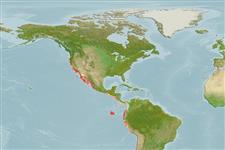>
Scombriformes (Mackerels) >
Trichiuridae (Cutlassfishes) > Lepidopodinae
Etymology: Lepidopus: Greek, lepis = scale + Greek, pous = foot (Ref. 45335); fitchi: Named in honor of the late John Fitch, indefatigable student of California fishes (Ref. 12696).
More on authors: Rosenblatt & Wilson.
Environment: milieu / climate zone / depth range / distribution range
Ekologi
laut bentopelagis; kisaran kedalaman 100 - 500 m (Ref. 6181), usually 100 - 250 m (Ref. 9351). Deep-water; 46°N - 17°S, 128°W - 75°W (Ref. 6181)
Eastern Pacific: Cape Kiwanda, Oregon, USA to the Gulf of California; then from 5°N to southern Peru.
Size / Weight / umur
Maturity: Lm ? range ? - ? cm
Max length : 210 cm SL jantan/; (Ref. 9351); common length : 150 cm SL jantan/; (Ref. 9351); Berat maksimum terpublikasi: 1.4 kg (Ref. 6181)
deskripsi pendek
Morfologi | Morfometrik
duri punggung lunak (Keseluruhan (total)): 78-87; Duri dubur 2; Sirip dubur lunak: 41 - 50; vertebrata, bertulang belakang: 84 - 93. Upper head profile slightly convex, rising gently from snout to dorsal-fin origin. Orbits nearly touching dorsal profile; interorbital space slightly concave. Pelvic fins reduced to 1 scale-like spine and 1 - 2 tiny rays. Pyloric caeca 16 - 18. Color of body is black or brown with a silvery shine along the abdomen.
Benthopelagic on the continental shelf and slope, up to a depth of 400 m or more; generally found over sandy bottoms at a depth between 100 and 250 m (Ref. 9351). During cold season, it is often seen near the surface at nights when the moon is full (Ref. 9351). May also be encountered in surge zones and sometimes observed to be beached in large numbers by the shore (Ref. 9351). A schooling species which feeds on cephalopods, euphausiids and small fishes, including Engraulis mordax and juvenile Merluccius productus. Marketed fresh and frozen (Ref. 9351). Excellent food fish, also processed into fish meal and oil (Ref. 9351).
Life cycle and mating behavior
Kematangan | Reproduksi, perkembang biakan | Pemijahan | telur-telur | Fecundity | Larva
Nakamura, I. and N.V. Parin, 1993. FAO Species Catalogue. Vol. 15. Snake mackerels and cutlassfishes of the world (families Gempylidae and Trichiuridae). An annotated and illustrated catalogue of the snake mackerels, snoeks, escolars, gemfishes, sackfishes, domine, oilfish, cutlassfishes,. scabbardfishes, hairtails, and frostfishes known to date. FAO Fish. Synop. 125(15):136 p. (Ref. 6181)
Status IUCN Red List (Ref. 130435)
ancaman kepada manusia
Harmless
penggunaan manusia
Perikanan: nilai komersial kecil
informasi lanjut
Umur / SaizPertumbuhanpanjang-beratpanjang-panjangukuran frekuensiMorfometrikMorfologiLarvaDinamika larvapemulihanKelimpahanBRUVS
AcuanBudidaya airprofil budidaya airStrainGenetikaElectrophoresesDiturunkanPenyakit-penyakitPengolahanNutrientsMass conversion
mitraGambarStamps, Coins Misc.Suara-suaraCiguateraKecepatanTipe renangArea insangOtolithsOtakPenglihatan / visi
Alat, peralatan
laporan khas
muat turun XML
Sumber internet
Estimates based on models
Preferred temperature (Ref.
123201): 8.2 - 15.4, mean 12.8 °C (based on 70 cells).
Phylogenetic diversity index (Ref.
82804): PD
50 = 0.5156 [Uniqueness, from 0.5 = low to 2.0 = high].
Bayesian length-weight: a=0.00275 (0.00105 - 0.00724), b=3.06 (2.83 - 3.29), in cm total length, based on LWR estimates for this (Sub)family-body shape (Ref.
93245).
Trophic level (Ref.
69278): 4.1 ±0.59 se; based on food items.
Daya lenting (Ref.
120179): Rendah, Waktu penggandaan populasi minimum 4.5 - 14 tahun (Preliminary K or Fecundity.).
Fishing Vulnerability (Ref.
59153): Very high vulnerability (90 of 100).
Nutrients (Ref.
124155): Calcium = 11.5 [5.3, 23.6] mg/100g; Iron = 0.289 [0.135, 0.650] mg/100g; Protein = 17.2 [15.5, 18.8] %; Omega3 = 0.209 [0.095, 0.481] g/100g; Selenium = 30.3 [11.9, 77.8] μg/100g; VitaminA = 8.03 [1.37, 41.90] μg/100g; Zinc = 0.26 [0.17, 0.43] mg/100g (wet weight);
